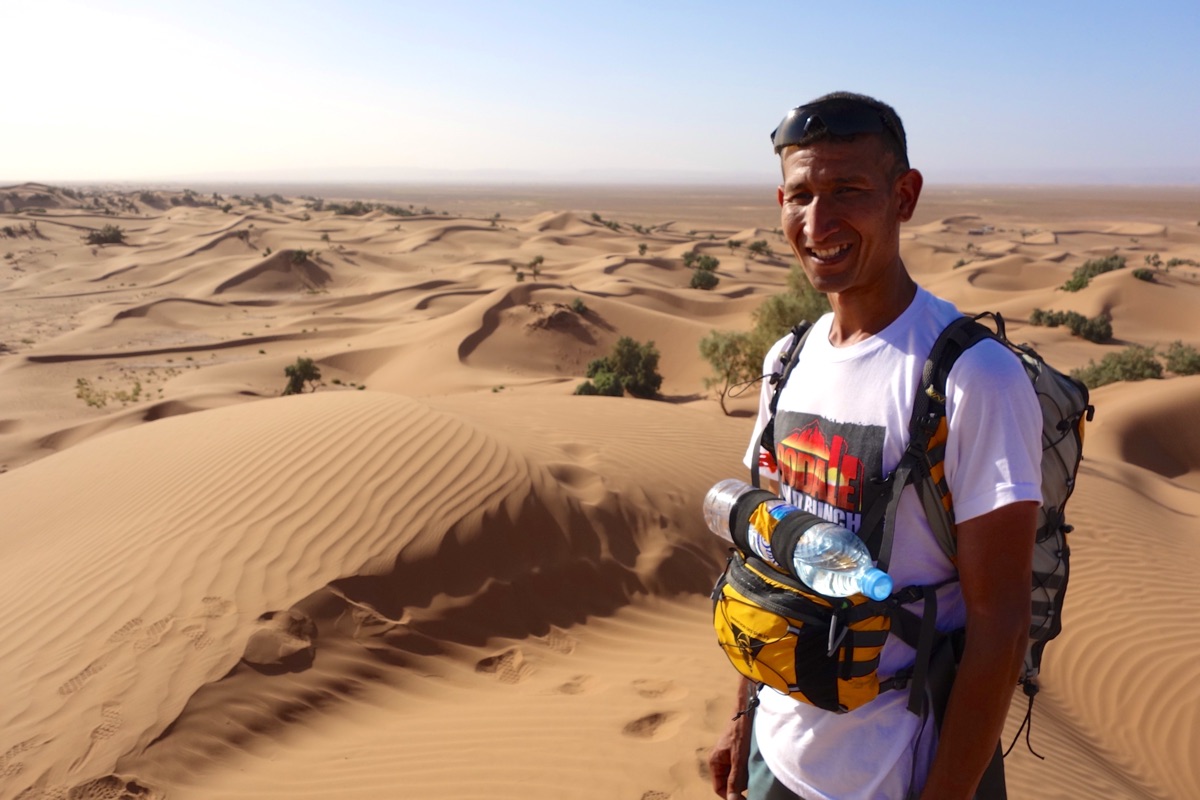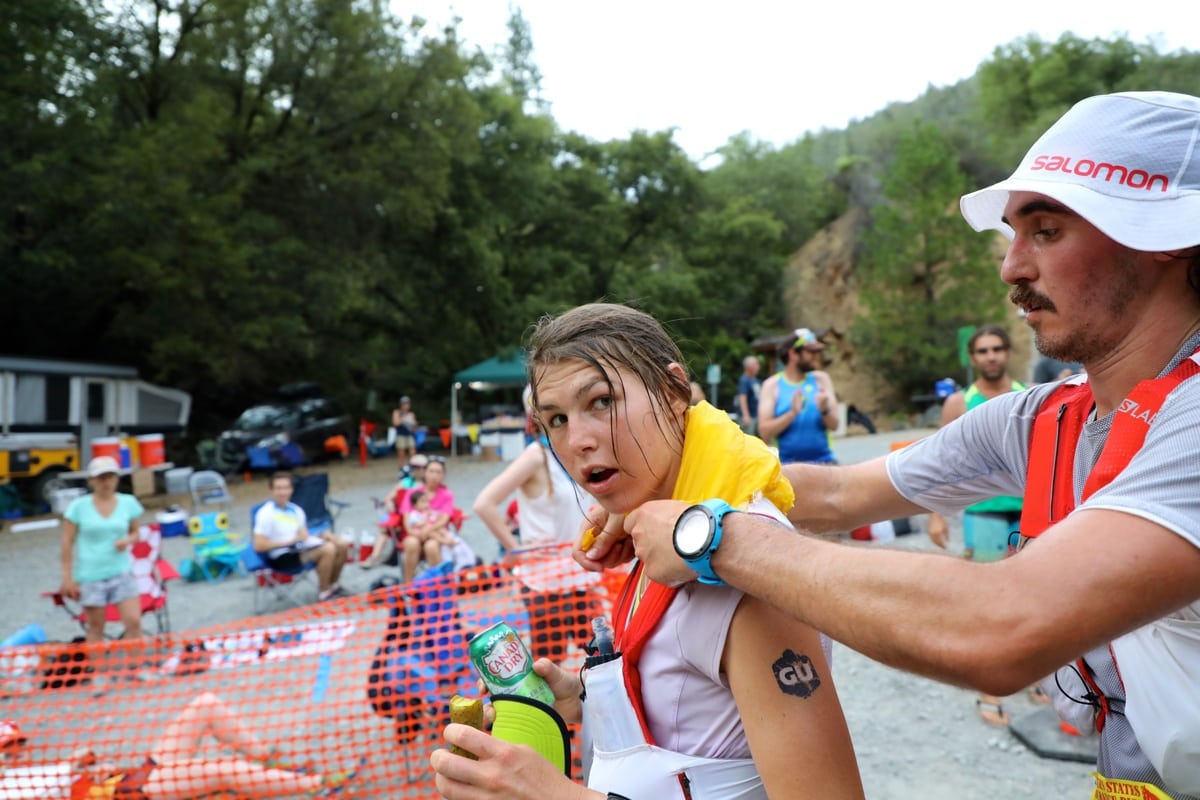
Like this article? Get your copy of the book “Where the Road Ends!”
Welcome to this month’s edition of “Where the Road Ends: A Guide to Trail Running,” where we discuss how to run safely in hot weather. “Where the Road Ends” is the name of both this column and the book Meghan Hicks and Bryon Powell of iRunFar published in 2016. The book Where the Road Ends: A Guide to Trail Running is a how-to guide for trail running. We worked with publisher Human Kinetics to develop a book offering the information anyone needs to get started, stay safe, and feel inspired with their trail running. The book Where the Road Ends teaches you how to negotiate technical trails, read a map, build your own training plan, understand the basics of what to drink and eat when you run, and so much more.
This column aims to do the same by publishing sections from the book as well as encouraging conversation in the comments section of each article. We want you to feel inspired and confident as you start trail running as well as connected to iRunFar’s community of off-road runners!
In this article, we excerpt from Chapter 7 to talk about the basics of staying healthy when running in the heat.
Extreme Heat and Performance
First things first, heat is detrimental to running performance. In a study of road marathoners, runners slowed from 1.6 to 3 percent for every 10 degrees over 55 degrees Fahrenheit (every 6 degrees over 13 degrees Celsius). This performance decline occurs because your blood supply is shifted from the leg muscles to the blood vessels near the skin in an attempt to prevent overheating.
Heat-Related Health Issues
Aside from decreased performance, it’s important to know that heat can lead to a host of minor and major medical issues. On the minor side, nausea can quickly creep into the picture, especially if you’re eating or drinking while running, as blood is moved from your gut to your skin and muscles.
Heat exhaustion and heat stroke are much more serious. Heat exhaustion can include the following symptoms: heavy sweating, rapid pulse, nausea, vomiting, fatigue, cool skin with goosebumps, headache, and dizziness. If untreated, heat exhaustion can progress to heat stroke, a serious medical condition in which the body temperature rises to 104 degrees Fahrenheit (40 degrees Celsius) or higher with other accompanying symptoms. Heat stroke requires emergency medical treatment to save the life of the afflicted person.
We say all this to help us instill a healthy respect for running in the heat, not a fear of it. It’s totally possible to stay healthy while running in the heat, and the rest of this article explains how.
Avoid the Heat
Perhaps the best way to deal with extreme heat is to avoid it altogether. Running where it’s shady can be a good way to stay cool. In a forest, the shade and plant-respiration-based cooling can often make the environment noticeably cooler than open space. Likewise, a run in the shadows of mountains or hillsides can be cooler than running on ridges. One key caveat for seeking out shade is that narrow, rocky canyons that receive midday sun can be much warmer in late-afternoon shade or even the following morning as the rocks bake and then radiate heat long after the sun is gone.
If you can’t find a locally cool environment for a midday run, try running early in the morning or at night. On average, days are at their coolest right at dawn, so the early bird certainly has an advantage here. Although it’s noticeably hotter at sunset than at sunrise, the environment cools down after the sun goes down. The longer you wait after sundown, the cooler things should be, so night owls have an advantage here. To avoid the worst heat, avoid running in mid- to late afternoon when temperatures are usually at their highest.
Get Naked, Get Wet
Should running in extreme heat be unavoidable, you have a couple of options for keeping yourself cooler.
To start, you can often wear less clothing that is lighter in weight and color. When running in full sunlight in the very hottest environments, however, you may want to opt for full-coverage clothing that is light colored, lightweight, and loose fitting to keep you cooler by reducing the amount of sunlight absorbed directly by your skin. Likewise, wearing less clothing on hot days needs to be weighed against exposure to the sun’s ultraviolet light.
Pam Smith, who won the Western States 100 in a blazing hot year suggests, “When getting dressed for a hot run it may seem like a good idea to wear as little as possible, but your clothing can actually assist you in combatting the heat by keeping the sun’s rays from directly warming your body. Either a hat or a visor will keep the sun off your face, but I always choose a hat because I can get it wet or put ice in it to cool my head. Some running hats have attachments to keep the sun off your neck. Light-colored clothing is preferred because it reflects sunlight away from your body. I like a short-sleeve shirt to keep the sun off my back and shoulders, but others wear full sleeves to protect the arms, too. I cover all my exposed skin with a thick layer of sunscreen. This will not only prevent a nasty sunburn, but also block ultraviolet rays (and their energy), which will keep you cooler.”
In drier conditions, you can douse yourself in water that you’re carrying or with water that you find along the way. That water will evaporate and cool your body the same way your sweat does. In rare circumstances when you’ll be running for a long time in hot, dry conditions and have ready access to water, you may choose a light- or moderate-weight cotton T-shirt to absorb water for prolonged evaporative cooling.
Immersing in a body of water also cools you quickly. In particular, submersing your core, neck, and hands can quickly lower your body temperature, so jump into that lake or lie down in that shallow stream on a scalding day.
When running from home, you can throw some ice in a water bottle you carry (great for quick cooling through your hands too) or in your hydration pack for internal cooling whenever you drink. Although a much rarer find on the trail, natural ice and snow also provide respite from the heat. Tucking some snow in a cap can keep you cool for longer than you think.
Speaking of hydration, be vigilant while hydrating in extreme heat. Read up on the basics of hydration in this article.
Staying Healthy in the Heat
Finally, each person reacts differently to extreme heat. In effect, we all have different heat tolerances. Our individual tolerances vary with our fitness levels and our acclimation to the heat in the preceding weeks and months. A lack of acclimation and its accompanying physiological changes is why a 70-degree Fahrenheit (21-degree Celsius) day in early spring can be debilitating, whereas the same conditions would be welcomed during the heat of summer. Allowing yourself 10 to 14 days to adjust to warmer conditions before a particularly strenuous run in heat can leave you more comfortable and safer.
Pam Smith, also a medical doctor, advises, “On your run, start conservatively. Because your heart has to do extra work pumping blood to the skin, all of your normal paces will require more effort. If you are racing, you will likely need to adjust your goal pace. If you do find yourself overheated, stop running! Even if you are in a race, remember that your health and well-being are more important than any finish time. Douse yourself with water to try to bring your body temperature down. If you feel okay, you can continue walking, but if you are lightheaded, having vision trouble, or throwing up uncontrollably, you should find a shady place to sit or lie down. Find help if you can. Otherwise, wait until you are feeling better and daytime temperatures have dropped before beginning to walk again.”
Excerpted from Where the Road Ends: A Guide to Trail Running, by Meghan Hicks and Bryon Powell. Human Kinetics © 2016.
To learn more about running safely in and acclimating to the heat, here are few resources:
- An in-depth guide to hot-weather endurance running;
- A how-to for identifying and caring for a runner who has heat exhaustion or heat stroke on the trail.
Call for Comments
Leave a comment to share your story of or questions about staying healthy when running in hot weather.


